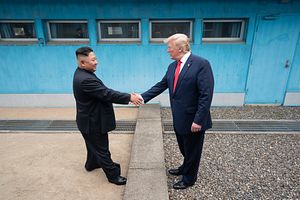It is difficult to review the last two years of U.S.-North Korea diplomacy and not feel a sense of dread about how little things have changed. Pyongyang’s rhetoric is getting more heated as the days go by. The North shut down all communications links and hotlines with South Korea last week and is even demolished the joint liaison office established pursuant to a 2018 inter-Korean agreement. Kim Yo Jong, Kim Jong Un’s powerful sister, is meanwhile referring to the South Korean government as “rubbish” that needs to be thrown in the trash.
Pundits and analysts in Washington have long come to see Trump’s diplomacy with Kim Jong Un as a catastrophe destined to fail from the very beginning. Those prescriptions, however, would be mistaken — the problem is not Trump’s decision to talk with Kim, but rather the administration’s highly unrealistic expectations of what can be achieved.
Trump’s top-down, tactical approach to North Korea is the polar opposite of his predecessors. His North Korea policy, however, was like an umbilical cord tied to the past. North Korea’s fully verified denuclearization was and indeed remains Washington’s first priority. Everything else — formal diplomatic relations between the United States and the North; U.S. support for inter-Korean exchanges; declaring a formal end to the 1950-1953 Korean War; the construction of a peace regime on the Korean Peninsula — played second fiddle to the nuclear issue. Fourteen years after the North conducted its first underground nuclear test, U.S. officials still inexplicably treat the elimination of Pyongyang’s nuclear weapons program as a realistic objective.
The reason Washington’s policy has been a failure for so many years is simple: the Kim regime views its survival as guaranteed by its nuclear deterrent. Negotiate that deterrent away, and the regime’s survival is put at extreme risk. For a country sharing borders with two nuclear weapons powers (China and Russia) and whose neighbors include two states (South Korea and Japan) protected by the U.S. nuclear umbrella, handing over its own nuclear deterrent on a silver platter is inconceivable. Given North Korea’s geopolitical circumstances, denuclearization would be highly illogical for any North Korean leader.
Fortunately, this obsession with regime survival also means that the Kim regime is highly unlikely to use its nuclear weapons in the field for fear of the extreme retaliation such use would inevitably provoke. In addition to the utter decimation of North Korea as a country, that retaliation would include the destruction of the regime — the very thing Kim Jong Un wants to avoid. Kim may run a totalitarian system of gulags and surround himself with a cult of personality, but he has proven himself to be as restrained by the concept of deterrence as the rest of us.
What, then, can the United States do to salvage a diplomatic effort with the North that is close to rupturing?
Washington should rethink its priorities on the Korean Peninsula and ask itself what is truly important to U.S. national security.
North Korea’s denuclearization would be a miraculous achievement of historic proportions, but the miraculous is rarely doable. Thankfully, a North Korea without nuclear weapons is not a requirement for keeping the United States safe. The U.S. has demonstrated an ability to effectively manage a nuclear-armed North Korea over the last decade and a half. As long as tensions are kept down and Washington does not overreact to every North Korean military or missile test, deterrence will continue to restrain the Kim regime from a recklessness that would usher in its own demise.
What Washington, Seoul, or Pyongyang can’t afford, however, is a war that would turn the Korean Peninsula into flames and quite possibly escalate into a nuclear exchange. A stable relationship between Washington and Pyongyang and between the two Koreas would nip such a disturbing possibility in the bud.
Last year, the Trump administration was debating the exchange of diplomats in one another’s capitals. The idea should be resurrected and pursued — not as a concession to the North, but as a straightforward, practical way to increase communications, enhance mutual understanding of one another’s positions, exploit opportunities for further dialogue, and deescalate tensions in the event of a mishap.
Washington should also provide South Korean President Moon Jae-in greater space to implement an inter-Korean rapprochement that would, in fact, hold significant security benefits for the United States as well.
In January, Moon proposed individual South Korean tourism to the North as a way to jumpstart his floundering peace initiative. The South Korean president has staked his legacy on turning the Korean Peninsula into a zone of pace and is no longer willing to wait on U.S.-North Korea nuclear talks to make progress. The White House can help speed things along by loosening some of the restrictions blocking the most minor inter-Korean projects from going forward, including South Korean investment in the North and the connection of the two countries’ road and rail networks.
If the United States hopes to get anywhere with North Korea, it needs to stop following the old playbook and move denuclearization to the side. If denuclearization is still possible, it will be a long-term process with multiple problems along the way. Improved relations leading to a historic peace does not have to wait.
Daniel R. DePetris is a fellow at Defense Priorities and a columnist at the Washington Examiner.

































